Unlock
The Tree With A
Pencil
August 2007
As
I have previously written, artists have degrees of confidence in
what they are able
to describe with paint. Confidence
grows the more
you paint, the more you discern, that is,
to select which
colors, which
strokes, which
details you want to INCLUDE, which also means
there will be colors and
details you purposefully choose to LEAVE OUT. When a piece
is done
out in nature, the decision-making
process is not easy. Tell me about it.
After the Merriam Exhibit was put up, I was eager to take my field gear
out and paint outdoors again.
A triangle of property east on
Highway B looked promising. During a recent bike ride I pedaled past
turquoise shoots against peach-colored
earth and bright
light blue gravel. The vines drew my interest.
I was certain I wanted to do
another work like Thursday Delight
On July 8th I
found that task
harder than I thought.
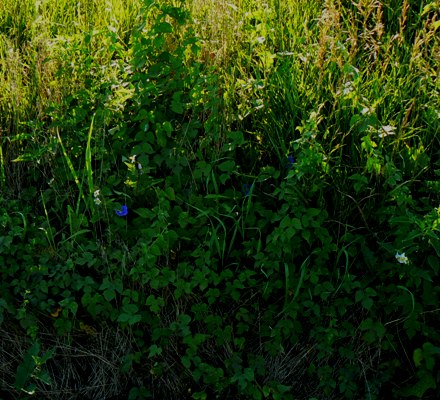
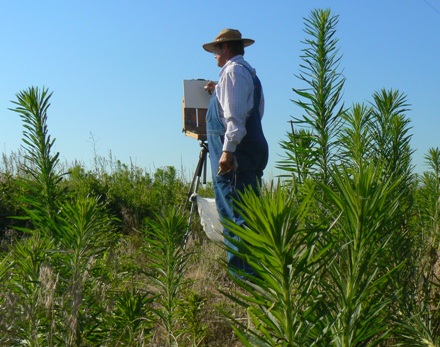
7.8.07 Green bank in shadow
at Highway B
triangle 7.8.07
Ready to work, looking at my subject.
Feeling the
warmth of the morning, the stillness, the meadow lark medley, trickles
of perspiration.
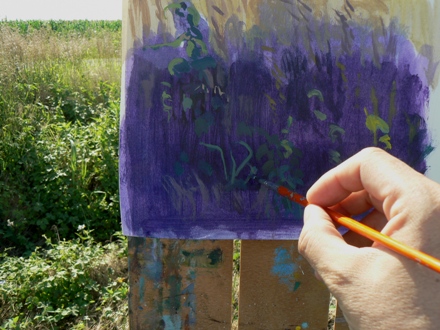
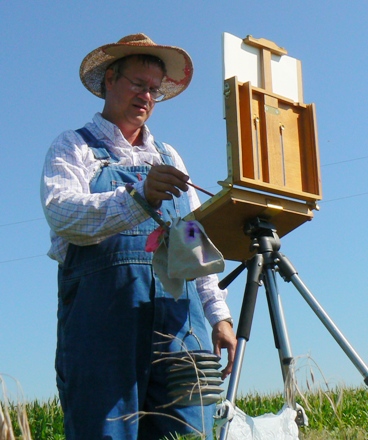
A wash of dark
purple and swiggles of color for plants on
top. Working in my
clean blue bibs.

Acrylic on watercolor paper I was disappointed
with
this.
It's not what I wanted. Admittedly, I
knew I was just going
through the motions. Setting up the gear,
pushing some paint, snapping
some pics, going at it
easy, tear down the gear, and trying it again
at another location, and learning
to SWEAT
under a July sun.
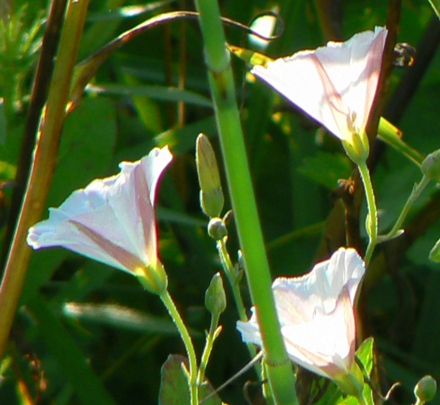
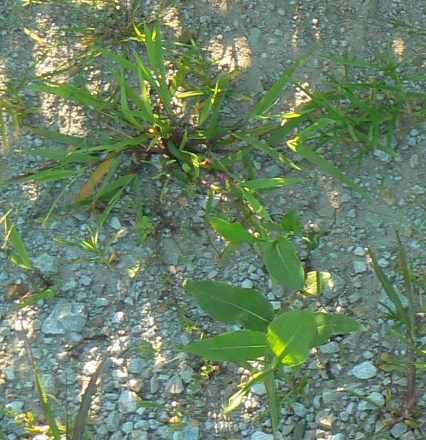

After lunch
at home, I returned to Austin Hollow, hoping to render
trees with paint, hoping to roam
the dry river bed. I found the bed with water in it this time, which
limited where I could set up.
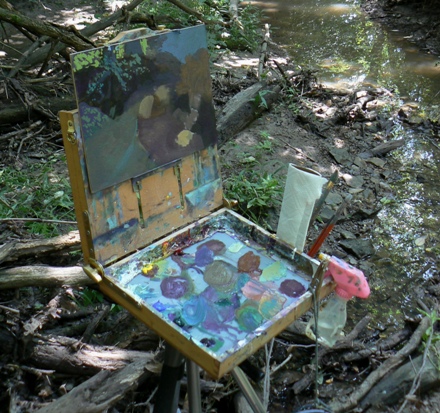
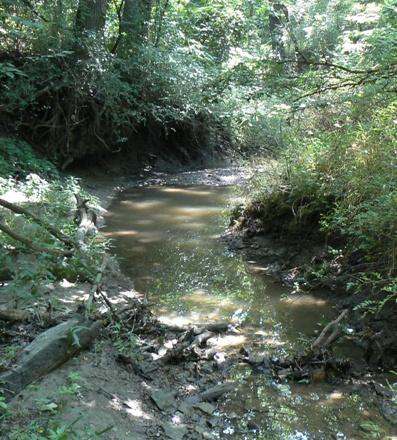
This painted
piece left me uneasy as well.
Here is
the scene I was working from.
There is just SO
MUCH INFORMATION coming at you
in nature. I had an idea that I was working
towards,
but the light kept shifting as the sun crossed the
sky.
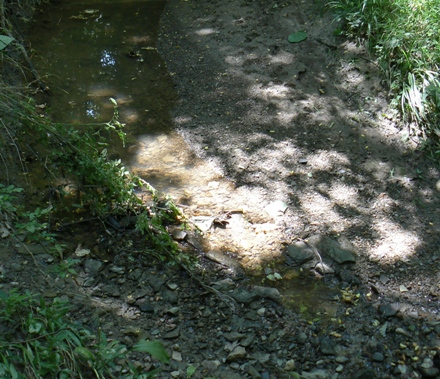
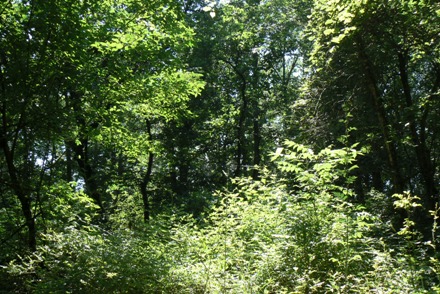
Light patches on
the ground moved around.
Light patches moved across the water I was painting.
Light patches
illuminated tree
branches and creek bank areas. That movement can be
disconcerting.
So I took photos. took my painting as far as I could
take it, then packed up
my gear and headed up the slope,
through the field, to my pickup truck, drove up to
the Austin's gate, got on the
gravel road to town,
and took Ely Street to
my house.
After being out I
realized it wasn't going to be easy. Nature can throw you off guard.
With no plan or
color strategy in place I would end up with duds.
I am
intrigued
by Juliet Hart Beers  26
x 17 inches, 1877
26
x 17 inches, 1877
In his oil painting Vermont
Summers plants overlap plants in negative
and positve forms, light on dark,
dark on light. You can tell from the close up
(below), that this painter knows his plant shapes, and
has a color strategy in mind throughout the
work.
He assembled elements and colors that he enjoyed.
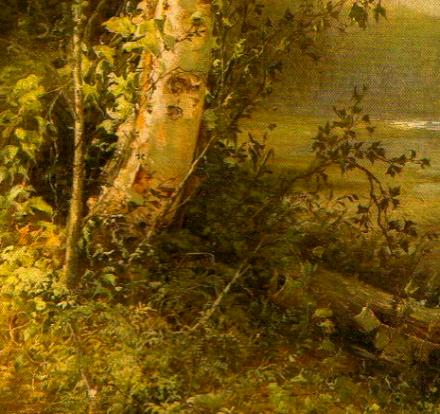 I painted from this work to learn
what I could.
I painted from this work to learn
what I could.
I
found Glen Harrington and Benjamin William Leader on the Internet. Both
of the pictures below
have color strategies I would like to embrace
in nature.

Glen
Harrington Gravel
Pool
14 x 18 Oil on linen

Benjamin William Leader An
Island on the Llugwy 14 x 18 oil on board
I told my wife "this
is the year of the tree." I want to be able to describe trees and
foliage with paint.
Charcoal studies helped me to understand cows.
Perhaps I needed to draw.
The local office supply
did not have charcoal pencils, so I ordered a dozen
design pencils with wide thick softer leads.
Then I sought out pencil instruction from the
Carrollton Public Library.
In Keys To Drawing (Northern
Light Books, 1985), author Bert Dodson suggests artists work with
two kinds of "handwriting," a loose free stroke and a
more deliberate controlled stroke. Through the
discipline of
copying one can learn the approach of another artist. When you emulate, you pick your
own idea and
render it in another artist's handwriting or expression.
So I began a series of pencil
scribbles, while looking at the trees in my backyard. Choosing to stay
loose.... to give my eyes time to become acquainted
with this new subject.
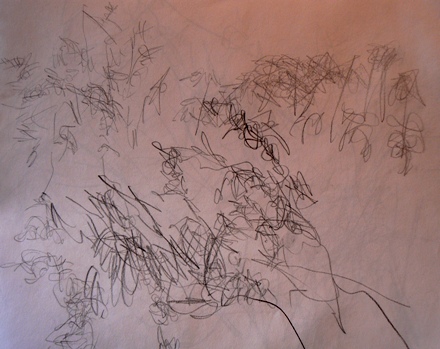
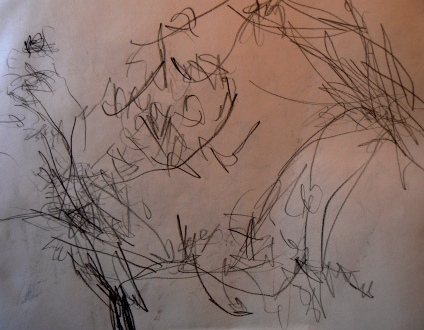
7.23.07 Pencil scribbles on journal pad
#1
7.23.07 Pencil scribbles #2
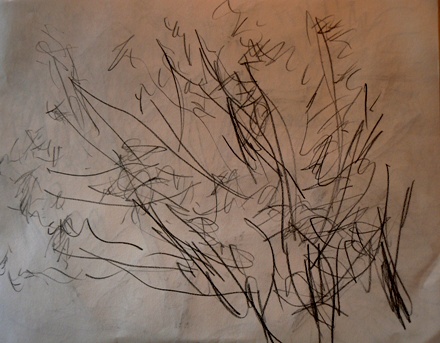
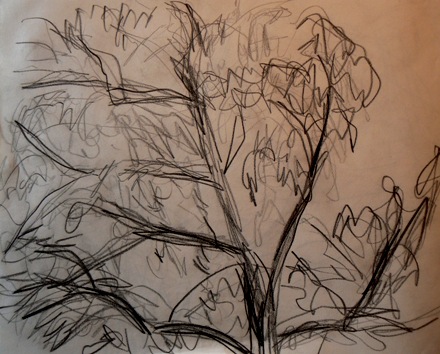
7.23.07
Pencil scribbles of tree #3
7.23.07 Pencil scribbles of tree #4
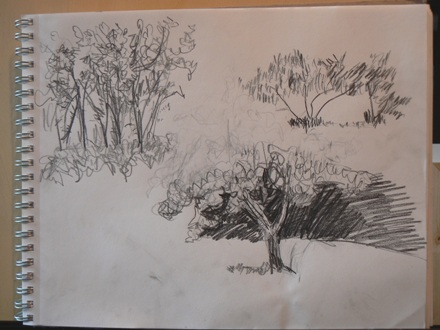

7.23.07 Pencil of bush row,sumac, and redbud
#5
7.24.07 Pencil scribbles of two trees #6
In Learn To Paint And Draw (Crescent Books, 1981) contributor
Alfred Daniels suggests that
catching the whole character of a tree is important. Doing
just closeup leaves and too much detail
can make a picture life-less. He describes doing outlines
of the bigger tree shape first, then working
with progressively smaller and smaller shapes within the
tree. Try to find the tree's character. Hmmm....
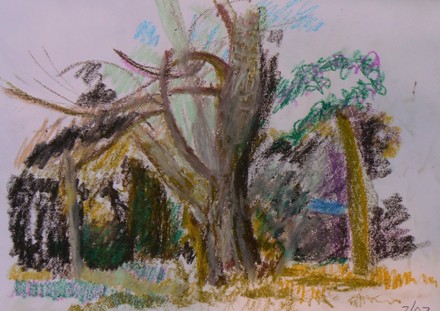

7.24.07 Craypa tree study #7
7.24.07 Pencil single tree #8

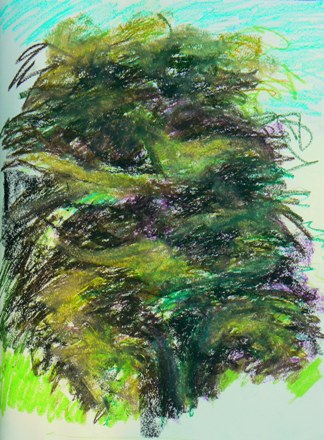
7.24.07 Pencil tree
#9
7.24.07 Craypa tree #10
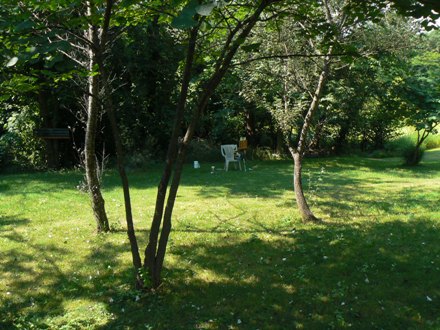
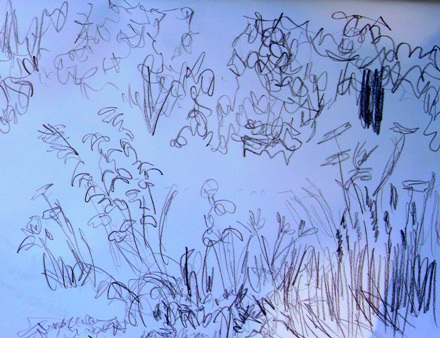
Side yard with trees
7.24.07 Pencil of flowers #11
I tried using wider color
marks with craypas, also known as oil pastels. I did not like the results. Yuck.
About the pencil though...I think it is like a magnifying glass,
in that, each stroke helps my eye
to rest on particulars
in nature. Nature is all that green stuff. When
you put down scribbles
of the page,
your eyes can focus on the edge of a leave, the groove
of tree bark, the curve of grass, the oval head
of Queen
Ann's lace. The mess of information is given a place in space on your page.
The next day I tried acrylic
bark studies on 9 x 12 watercolor paper. Here they are (below).
Working on small passages of bark and leaves and
sky.....reminded me of creating poetry.
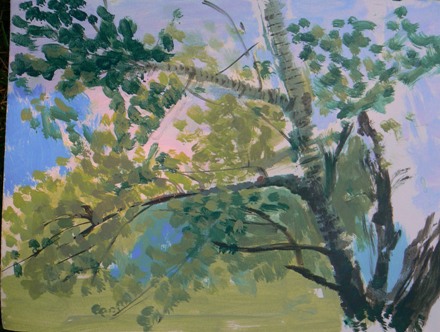
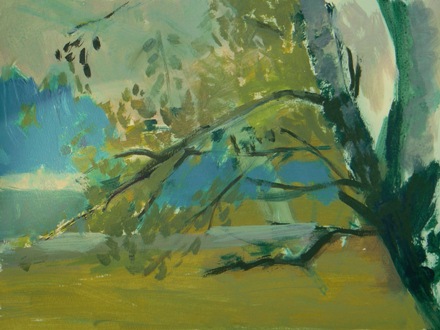
7.25.07 Acrylic Tree branches
#1
7.25.07 Acrylic Tree branches #2
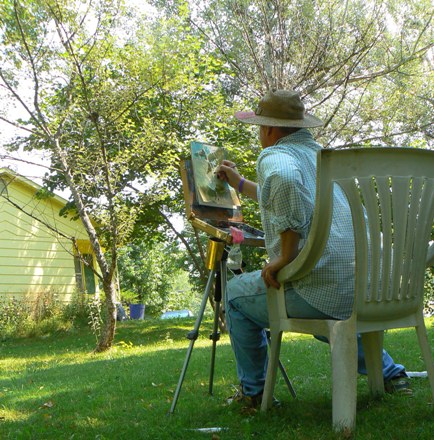
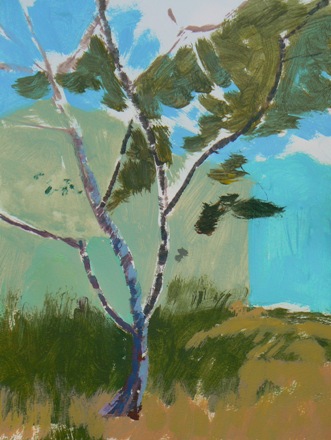
7.25.07 Painting tree in my side
yard
7.25.07 Acrylic Tree Branches #3
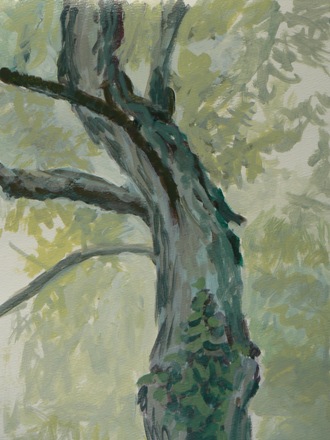
7.26.07 acrylic bark and leaves
#4

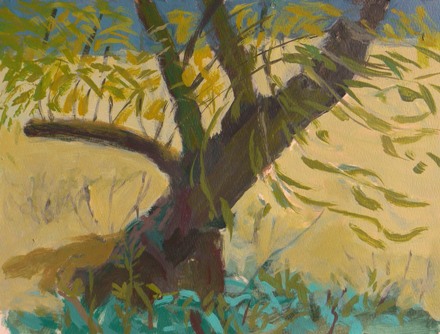
7.26.07 beside willow tree on Colborn
Pond
7.26.07 acrylic bark and leaves #6
I was daily showing my attempts to my friend Joe
Tonnar. An excellent drawer, Joe was struggling
with wanting to paint in oil. It was new territory for
him. Each of us were facing our own struggles, wanting
so much to grow. What I call homework. You can see his progress at One Week
As confidence rose, I then tried
three works on canvas panels. These supports are made by a
professional outfit.
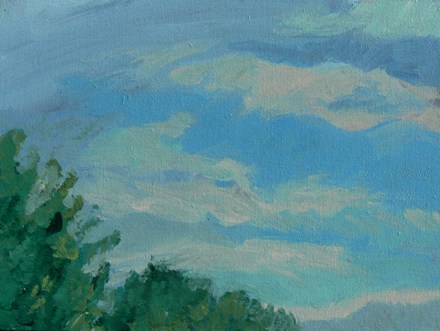
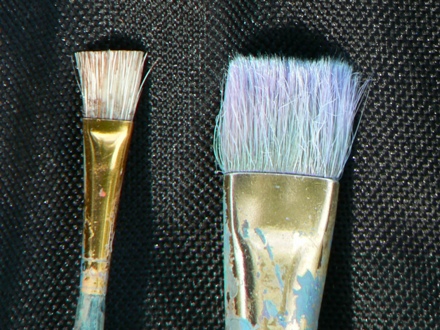
7.27.07 acrylic clouds above tree tops
#7
Square brush on left was helpful for thin lines and branches.
(Here, I had almost thrown it away)

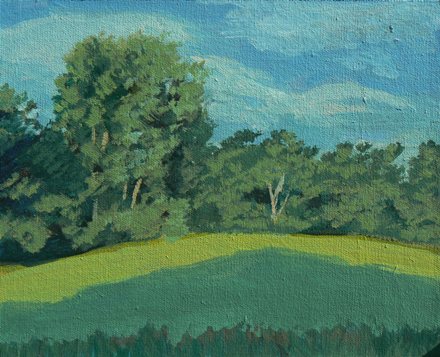
7.27.07 morning session out across Colborn
Pond 7.27.07
acrylic Colborn Pond 9 x 12 canvas panel #8
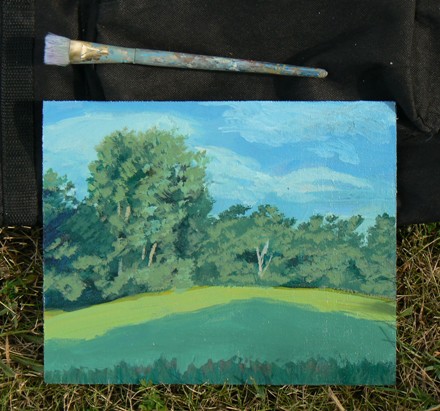
All of this was painted with one brush. My
friend Mark Hemleben had been
right all along.
When I visited him in Jerome, he had told me he painted with a
similiar kind of brush. A brush it seemed
that was too big to put down small details in paint.
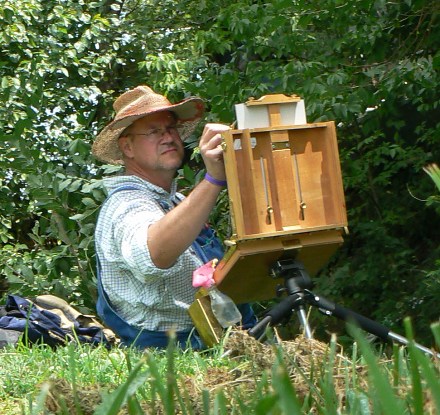
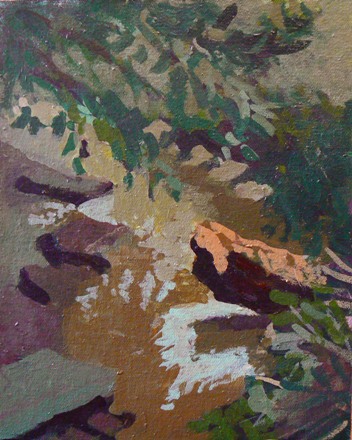
7.27.07
Working on the banks of the Stanley
Branch
7.27.07 Stanley Branch 8 x 10 on canvas panel
This time I tried to
use colors that Harrington might have used. There was a juggling act
going on while I worked.
Purposefully...tackling the rocks jutting above the surface....working
with the light on top of the log and
the dark shadows
beneath it...choosing sky colors in the reflection near the
log...trying out strokes
for the leaves that
hung down across the water...trying out greens mixed from my limited
palette of
titanium white,
veridian hue, alizeran crimson, and cadium yellow.
At the beginning of
this session I sat and looked at my subject...I looked at my color copy
of Harrington's
painting.. I
feel, much like Austin Hollow, there was MUCH information put down. A
patchwork of solutions,
using paint to
describe rock, water, plants, and banks. It might not look like much to
you, but I am
satisfied...I am on my
way...I can do this...there is
hope...this makes me want to
go-at-it-again...this is a good
thing...
this session was useful...the homework
gets inside you....it builds confidence.
Home
Unlock
The Sorrel Mule With A Pencil
One
Week
Going Large In The Side Yard
canvas panels www.raymarart.com
outdoor easel
and tripod set www.artworkessentials.com
Mark Hemleben www.markhemleben.com
free web page
maker www.mozilla.org/projects/seamonkey
 26
x 17 inches, 1877
26
x 17 inches, 1877 I painted from this work to learn
what I could.
I painted from this work to learn
what I could.